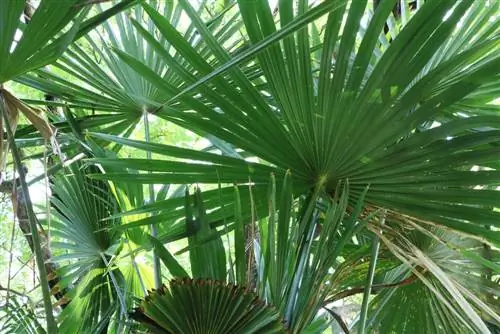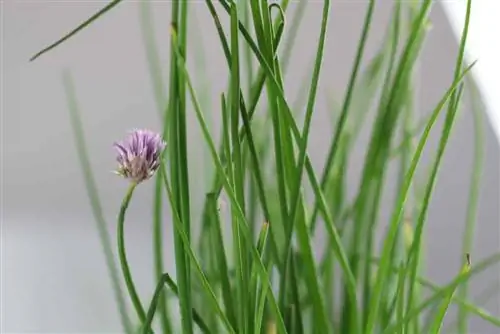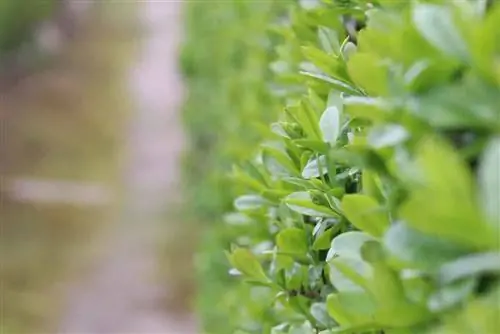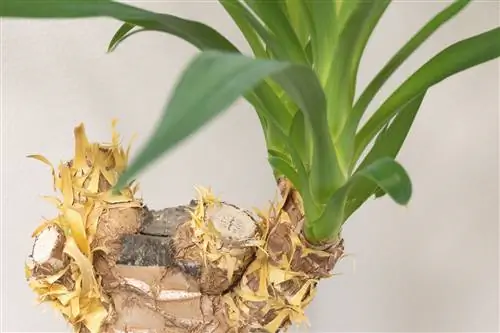- Author admin [email protected].
- Public 2023-12-17 03:39.
- Last modified 2025-06-01 06:48.
In itself, the hemp palm is an easy-care and resilient plant that doesn't require much effort. However, it can reach astonishing heights and assume expansive proportions. The purchase for the living room, winter garden or outdoor space therefore needs to be carefully considered. In addition, certain factors must be taken into account during cultivation so that the plant can thrive successfully. With the appropriate knowledge, even beginners in plant care without a green thumb can cultivate the hemp palm.
Location
The hemp palm does not need tropical conditions, but does require plenty of light at the location. However, direct sunlight can be dangerous for some Trachycarpus.
A safe choice is light partial shade.
Apart from the lighting conditions, the location for the hemp palm should be protected from the wind. The plant does not tolerate cold wind particularly well. You should also keep this in mind if you want to give the palm tree a location outdoors.
Substrate
The Asian hemp palms are easy to care for overall - but are extremely picky and sensitive when it comes to the substrate. So it's important to be particularly careful here.
A mixture of loamy, coarse-grained soil, sand and gravel is ideal. Quartz grit, lavalite, perlite or clay granules can also be used as alternatives to sand and gravel. This addition is important in any case in order to loosen the substrate, make it permeable to water and prevent waterlogging. For this reason, a drainage layer should also be added to the planter or planting hole.
A little humus can be added to this combination as a beneficial addition for a slightly acidic pH value. Instead of your own mixture, special palm soil can also be used. Again, it is recommended to loosen it up by adding appropriate gravel or granules.
Pouring
The hemp palm doesn't like waterlogging, but it doesn't like drying out completely either. Especially in summer, it is therefore necessary to water more frequently depending on the temperature and humidity.
Watering is done so that the substrate is completely soaked - but the plant is not standing in water. The soil is then allowed to dry out. If the top layer is no longer moist, you can water it again. In the warm seasons this may be necessary two to three times a week.
Ideally, rainwater or soft tap water is used. Since larger Trachycarpus require plenty of it, it is hardly possible to collect appropriate quantities, especially in periods of low rain or when growing indoors. In addition, the tap water in many regions is quite hard and therefore has a high lime content.
In these cases, it is recommended to pour water into buckets or watering cans and let it stand for a few days. As a result, at least some of the lime settles and collects on the ground or in the lower layer of the water. As long as the sediment is not used, the water is comparatively soft.
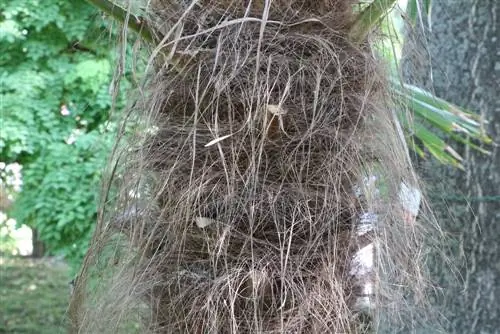
When cultivating the hemp palm outdoors, there is no need to water as long as there is enough rain. In addition, the plant can take care of itself better here than in a bucket. However, care should be taken to ensure that the soil does not dry out completely.
The watering behavior continues in the winter. However, the intervals between waterings are significantly longer.
Fertilize
Under optimal conditions, hemp palms can grow up to 40 centimeters in height per year and also increase in size accordingly. This means they have a fairly high nutrient requirement during the growth phase.
Fertilization is carried out every 14 days from April to September. Complete fertilizers that are administered in the form of powder or a liquid solution are suitable. It is important to provide the trachycarpus with sufficient water. Otherwise, the fertilizers can cause chemical burns on the roots.
Alternatively, a slow-release fertilizer can be used. For example, in the form of sticks that are simply stuck into the ground. From September onwards, fertilization is no longer carried out so that the hemp palm can prepare for the vegetation phase.
Cutting
The hemp palm will repeatedly develop dried leaves over the course of its life. These are not particularly decorative, but are not dangerous for the plant itself either. The Trachycarpus does not necessarily require a trimming, but it is possible for optical reasons.
It is ideal to wait until the leaf has completely dried. Then place two to three fingers wide of the trunk of the palm tree and cut off the leaf with clean scissors. The dried leaf or stem residue should remain on the trunk so as not to cause any damage or wounds to the hemp palm. This could serve as a gateway for pests and pathogens.
Aside from cutting dry leaves, it may also be necessary to cut leaves that are still green. For example, because a sheet has been bent or otherwise damaged or there is not enough space for the expansive shape. In these cases, clean - preferably freshly disinfected - and sharp scissors are used.
Green leaves are cut at a distance of about 15 centimeters from the base of the plant. If the remaining leaves have dried over the course of a few weeks, they can be cut again as described above.
Culture in the open air
Since the hemp plant comes from Asia, or more precisely from the Himalayas, it is comparatively robust and can withstand sub-zero temperatures. In regions with mild winters, it is therefore possible to plant the Trachycarpus directly outdoors.
As mentioned, the hemp palm needs a light spot in partial shade and a location protected from the wind. It should be noted that the Trachycarpus can reach a height of up to ten meters outdoors and become quite sprawling. This means that a distance of two to three meters should be maintained from fences, buildings and walls as well as other plants.
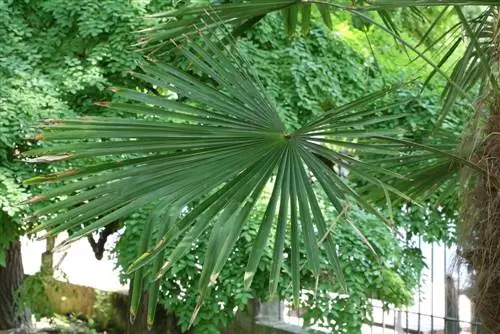
Apart from this, outdoor care is comparatively easy. From April to September, the hemp palm is fertilized every two weeks. It is also important to ensure that it is supplied with sufficient water. Some effort only needs to be put into planting and preparing the crop outdoors.
Planting outdoors
If the hemp palm is to be planted outdoors, some preparation and the consideration of certain factors are necessary. First and foremost, the age of the palm tree. This must be at least three years old before it can survive a frost. Furthermore, proceed as follows:
- The planting time should be late spring or early summer. So a date when heavy frost is no longer expected - but the plant still has as much time as possible to grow.
- Look for a location that offers at least four to six square meters of free space, is protected from the wind and in light partial shade. Direct midday sun must be avoided.
- The planting hole should be at least two to three times as large as the root ball. Bigger is better. The difference between the root ball size and the planting hole is filled with palm soil or a substrate mixture according to the specifications described above.
- Before adding the appropriate soil, a light drainage layer should be laid. Larger stones and gravel, pottery shards and sand are ideal for this.
- After inserting and filling the planting hole, care should be taken to ensure that there is sufficient substrate. If it sinks, palm soil must be refilled.
If there are no shady plants or buildings in the surrounding area, the hemp palm should be given additional sun protection, at least at the beginning. Mats made of straw or bamboo, as well as sun sails or umbrellas, are well suited for this. It is beneficial if the plant can gradually get used to the sunlight.
In winter, the hemp palm should also be given some protection. It is recommended to pile up soil or straw around the Trachycarpus. As well as watering on frost-free days when the substrate has dried out. Further winterization tips can be found below.
Bucket Culture
The pot culture of the hemp palm has a number of advantages. The Trachycarpus becomes “mobile” so to speak and can stand in the living room, winter garden or on the balcony. In addition, the hemp palm does not reach such enormous dimensions with this variant of the culture.
However, the effort required for care also increases, at least in terms of watering and cuttings. Repotting is also necessary, which is unnecessary after planting outdoors.
It is important that the hemp palm cannot overwinter outdoors in a pot. Not even if the planter is covered with frost protection fleece. For very large specimens that are left outdoors in summer and for which there is no space in the house or apartment, a suitable place for overwintering should be found in good time.
Repotting
In pot culture, repotting is necessary every now and then. This measure is necessary at the latest when root ends appear at the bottom of the pot. Since the Trachycarpus plants are deep-rooted, this happens relatively quickly.
As a rule, it is necessary to change the substrate and enlarge the planter at least every three years. The following factors should be taken into account:
- As deep-rooted hemp palms need downward space. The planter should therefore be higher than it is wide.
- The roots should be completely freed from the old soil when repotting. This prevents illness and improves nutrient absorption.
- The pot should only be one size larger than the last planter. Otherwise, the Trachycarpus puts too much effort into the development of the roots to achieve sufficient stability. The Asian palm should therefore be replanted more often instead of suddenly having significantly more free space in the root area.
Tip:
Carry out the repotting with at least one helper. This is necessary, especially with larger hemp palms, simply because of the effort required. Even with rather small specimens, it makes work easier.
Wintering
Wintering in containers and with year-round care in the apartment is very easy. The hemp palm can remain where it is during the rest of the year. Fertilizing is avoided and the intervals between waterings are longer.
When cultivating larger hemp palms outdoors, a nursery can also be commissioned to take care of them in the winter. This is particularly recommended if there is no space for the Asian Trachycarpus in the apartment or house.

If the hemp palm was planted outdoors, several protective measures are required for successful overwintering. These include:
- Pile up soil, straw or compost around the hemp palm
- Tie the palm fronds together and gently wrap them with a soft ribbon or bubble wrap. The resulting funnel should also be filled with straw.
- Lightly wrap the entire plant with garden fleece or bubble wrap
Propagate
The hemp palm can be propagated via seeds. However, this requires fruiting bodies, which only develop after spending enough time outdoors. Harvesting, sowing and germination require a lot of patience and endurance.
If you are lucky enough to find seeds, place them in sterile growing soil, keep the seeds and substrate moist and practice waiting.
Diseases, pests and care errors
Hemp palms in this country generally have nothing to do with pests. They are simply too far away from their homeland to have natural enemies here.
The situation is similar with diseases.
However, hemp palms are not immune to care errors. The main problems are incorrect choice of location, waterlogging, a lack of nutrients and a lack of protection in frosty times. If the hemp palm does not want to grow properly or is damaged, the care factors should first be put to the test.
Conclusion
With a few tricks and the appropriate knowledge, the hemp palm is robust, easy to care for and not susceptible to diseases. However, it is not completely immune to damage and care errors. If you want to cultivate them successfully, you should inform yourself in advance and have enough space available.

